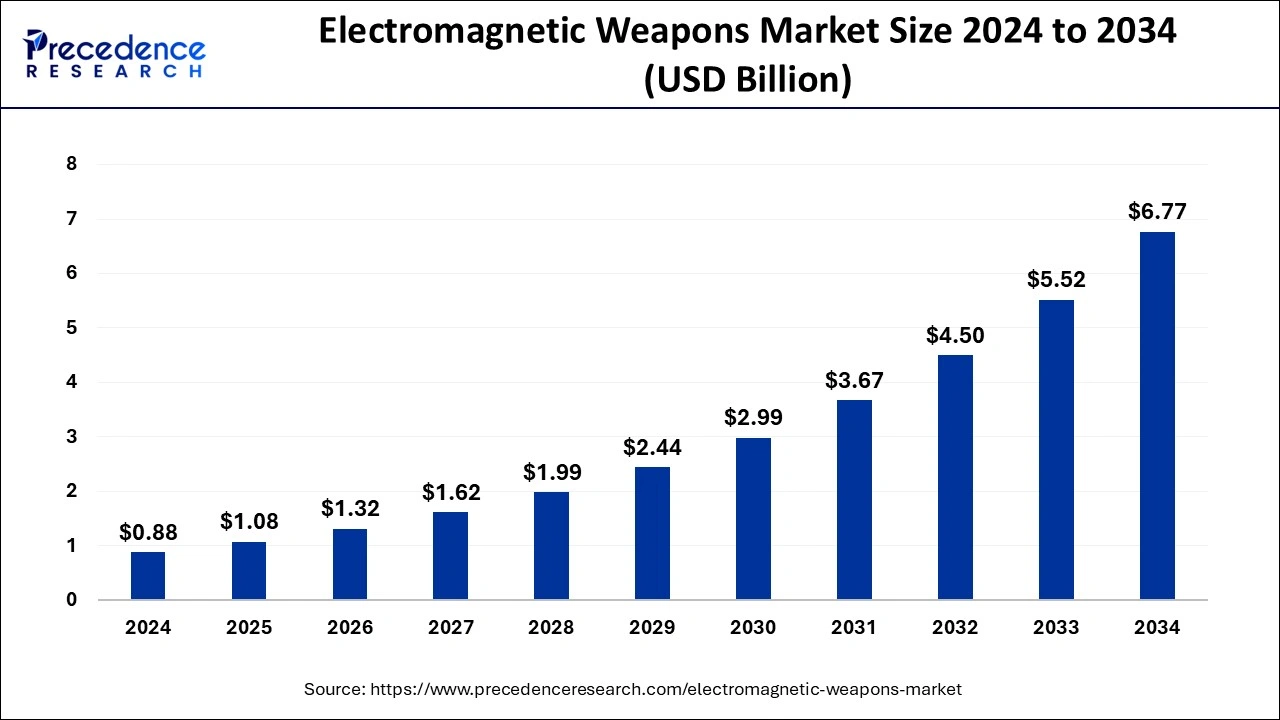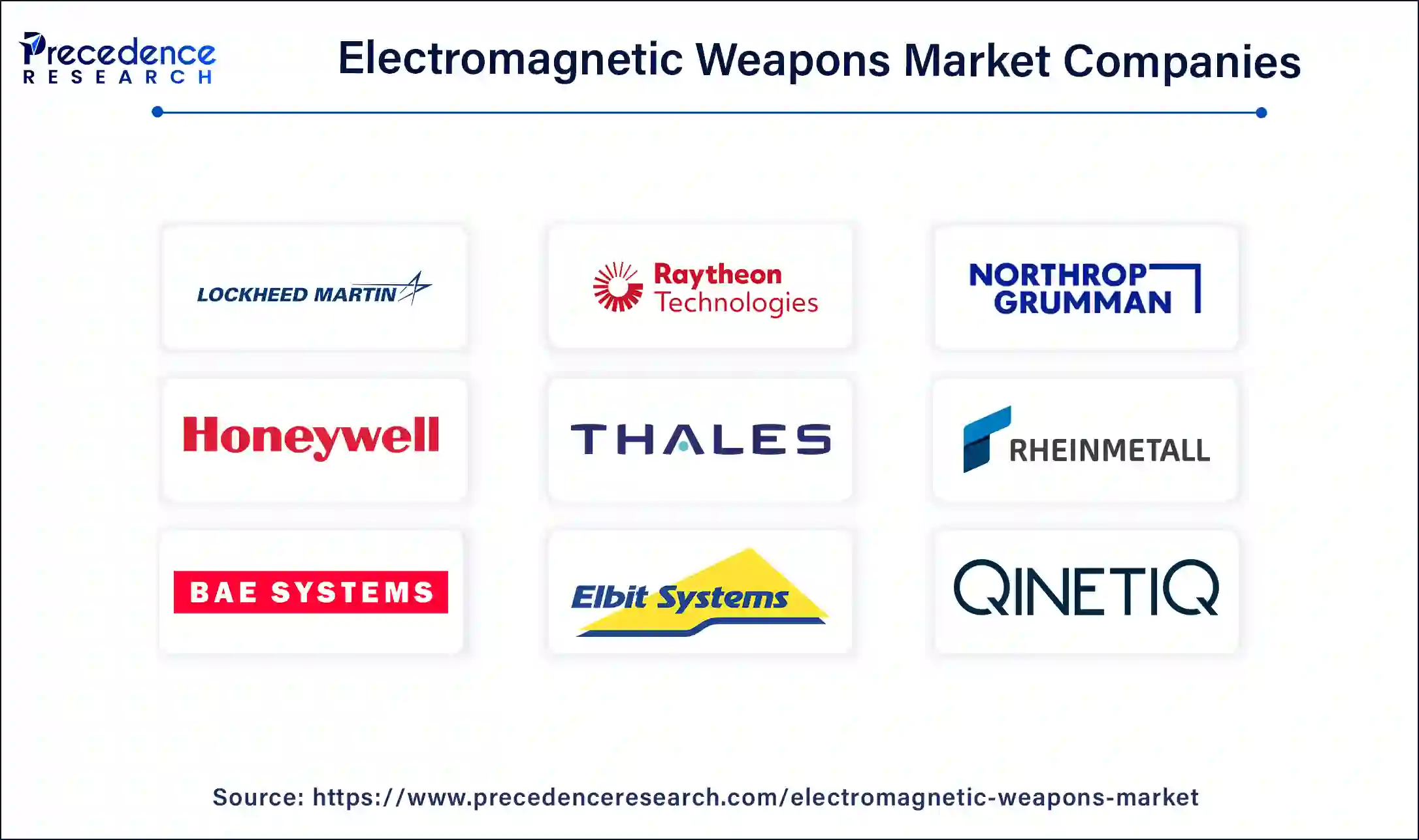February 2025
The global electromagnetic weapons market size is calculated at USD 1.08 billion in 2025 and is forecasted to reach around USD 6.77 billion by 2034, accelerating at a double-digit CAGR of 21.63% from 2025 to 2034.
The global electromagnetic weapons market size accounted for USD 0.88 billion in 2024 and is expected to exceed around USD 6.77 billion by 2034, growing at a healthy CAGR of 21.63% from 2025 to 2034. The electromagnetic weapons market is continuing to grow due to increased defense budgets, advancing technologies, and increasing threats.

AI plays an essential role in supporting modern weapon systems as devices that bring higher speed, accuracy, and effective organization of military actions. Artificial intelligence or machine learning (AI/ML) is the leading driver of warfare modernization within the Department of Defense (DoD). AI/ML is a fundamental force multiplier in electronic warfare and can be an extremely effective tool when applied to areas such as signal recognition, emissions and signal control, emitter classification, threat recognition, and jamming identification. AI/ML is also beneficial in analyzing tasks, as it takes less time and effort for it to complete the tasks instead of the human operator. Electromagnetic spectrum lead has a direct effect on the information domain in combat.
Electromagnetic weapons utilize electromagnetic energy as a medium of transferral of heat, mechanical or electrical energy to cause pain or permanent damage to the target. These weapons are effective in disruptive interference with the functioning of electronic equipment and the destruction of physical items with a high degree of electromagnetic pulses. These weapons cause detrimental voltage within an electric wiring, which affects the electrical part of a system. Electromagnetic weapons aimed at electromagnetic power paralyze specific enemy electronics that are useful for communication, navigation, guidance, computation, and presentations.
The need for sophisticated methods to protect military operations continues to drive the use of electromagnetic weapons. Increasing threats from cyber-attacks, electronic warfare, and unmanned systems have augmented the need for high-power RF and millimeter-wave weapons development. It has been predicted that the electromagnetic weapons market holds a greater potential for future growth due to factors like a rise in military spending, government support, and continual progression and procurement of modern attack instruments, smart firearms, intelligent fabrics, and active denial systems.
| Report Coverage | Details |
| Market Size by 2024 | USD 0.88 Billion |
| Market Size by 2025 | USD 1.08 Billion |
| Market Size by 2034 | USD 6.77 Billion |
| Market Growth Rate from 2025 to 2034 | CAGR of 21.63% |
| Leading Region | North America |
| Fastest Growing Region | Asia Pacific |
| Base Year | 2024 |
| Forecast Period | 2025 to 2034 |
| Segments Covered | Technology, Application, Platform, Product, and Regions |
| Regions Covered | North America, Europe, Asia-Pacific, Latin America, and Middle East & Africa |
Increasing demand for electromagnetic weapons in combat
The electromagnetic weapons market is encouraged by the increased application of electromagnetic systems in operations, the advancement of weapons in military systems, and the invention of small-scale electromagnetic weapons for unmanned aerial vehicles. Defense agencies around the world are developing electromagnetic weapons and EMP generators to neutralize threats and continue to superior defense across land, sea, and air. The companies are investing in electro-magnetic firearms to enhance the security of airplanes, naval vessels, and ground vehicles. Sophisticated systems of electromagnetic armament assist defense organizations in providing a prompt reaction to enemy strikes. It is expected that the requirements for electromagnetic weapons in combat operations will continue to rise, and modernization and investments in the defense sector will be directed toward developing electromagnetic weapons for a military platform.
Damage potential
Several restraints are preventing the growth and the establishment of the electromagnetic weapons market. An important obstacle is that electromagnetic weapons are mainly aimed at imposing damage through the use of electromagnetic radiation, which a complex technology makes difficult to create. These technologies need improvement in power densities, range, and reliability, which is an expensive and time-consuming process. Also, these weapons are very expensive to manufacture and develop. Legal issues also present difficulties; electromagnetic weapons can also violate international agreements in the sphere of constraints of the utilization of weapons or elicit the misuse of disruptive technologies in warfare. Collateral damage is accidental harm to people and facilities that are not involved in a conflict. Electromagnetic weapons (EMPs) can cause irreversible damage to electrical and electronic equipment, which can lead to damage.
Upsurge in research and development
The need to foster investments for the development of electromagnetic weapons to be incorporated into air and missile defense and anti-surface warfare drives the growth of the electromagnetic weapons market. The development of modernized weapons and technologies for innovation is expected to help the electric industry inducing the global electromagnetic weapons market. It means that the growth in demand for small electromagnetic weapons for unmanned aerial vehicle and their use in combat operations have caused market growth. Governments are investing in research and development of electromagnetic weapon technologies to strengthen their military forces. In addition, the progress in technology and the rise of R&D of electromagnetic weapons worldwide are gradually helping to gain opportunities within the forecast period.
The particle beam weapons (PBW) segment held the dominating share of the electromagnetic weapons market in 2024. Particle beam weapons are a type of directed energy weapon that uses high-energy beams of matter particles to strike targets. The concept of removing a target’s atomic and molecular bonds through a raging beam of accelerated particles. This growth can be attributed to the particle beam weapons’ installation configuration and low power usage. Particle beam weapons immobilize, damage, or destroy a target by projecting a stream of highly charged atomic particles. These weapons are of two types: charged particle beam weapons and neutral beam weapons; charged particle beam weapons fire accelerated charges such as electrons and protons and obtain kinetic energy, as does a bullet fired from a gun. Particle beam weapon has the potential of heating the target to very high temperatures, thus causing damage.
The naval platform segment held the leading share of the electromagnetic weapons market in 2024. Modern naval forces have made use of electromagnetic weapons as part of the defense mechanism against missiles and drones. Emerging technology, such as High Powered Microwave Systems and Electromagnetic Railguns, makes it possible to spike electronics in the enemy ship. Naval electromagnetic weapons systems are referred to as the equipment applied specifically for naval purposes like combat ships, submarines, etc. The naval part consists of combat ships, submarines, and unmanned surface vessels. Defense ships are specially designed for use by coast guards and the navy to protect the water borders from any threats. The defense ships are built for the Coast Guard and Navy services to protect water boundaries.
The lethal weapons segment held the dominating share of the electromagnetic weapons market in 2024. These lethal products, primarily for specific use in military operations, are rail guns, electromagnetic bombs – e-bombs, nuclear and non-nuclear electromagnetic pulse – EMP, and high-power microwave guns. Huge investments are being worked into the development, as well as demonstration and experimentation of lethal electromagnetic weapons. Among rail guns, electromagnetic bombs and plasma cannons, microwave guns, navy laser cannons, gun-fired guided projectiles, automatic shotguns, and other lethal products.
North America dominated the electromagnetic weapons market in 2024. Due to the increased budget for defense, continuously carrying research and development and implementation of new technological warfare equipment such as smart fabrics and smart weapons. Significant defense spending, advanced technological infrastructure, and the presence of leading defense contractors. Directed energy weapon (DEW) and electromagnetic pulse (EMP) are the classified weapon systems that the U.S. military has been researching and developing under its defense technologies banner. It is believed that these weapons are necessary to respond to novel threats and improve performance in electronic warfare. Such prominent Research programs and procurement techniques set by the US Department of Defense offer North America a dominant position in this sector.
During the forecast period, Asia Pacific is expected to grow at the fastest rate in the electromagnetic weapons market. The need for electromagnetic weapons has risen over recent years due to economic growth in the region, the upsurge in security challenges facing various countries, and increased tensions along borders. Several countries in the region are militarizing and upgrading their weaponry, especially with an eye toward potential threats. EM weapons have been viewed as a useful component of next-generation military systems, such as missile defense, electronic attack, and counter-UAV. China, Japan, and India have stepped up their defense budgets due to a higher probability of being attacked by terrorists.

By Technology
By Application
By Platform
By Product
By Geography
For inquiries regarding discounts, bulk purchases, or customization requests, please contact us at sales@precedenceresearch.com
No cookie-cutter, only authentic analysis – take the 1st step to become a Precedence Research client
February 2025
August 2024
January 2025